What I want in a Music Streamer is a one-stop-shop. While sound quality is first and foremost, convenience and ease of operation are the primary reasons for having a Music Server. Over the years, my one complaint of all the Music Streamers I have reviewed is the need for an external computer or server to house my drives and run the control software. I mean, Roon is great and all, but I prefer to do as much as possible in hardware rather than software as it is more efficient and in high-end audio efficiency of signal path equates to sound quality. Enter the Matrix Audio element X2 Music Streamer, it truly fits the bill, in spades.
The Matrix Audio element X2 Music Streamer:
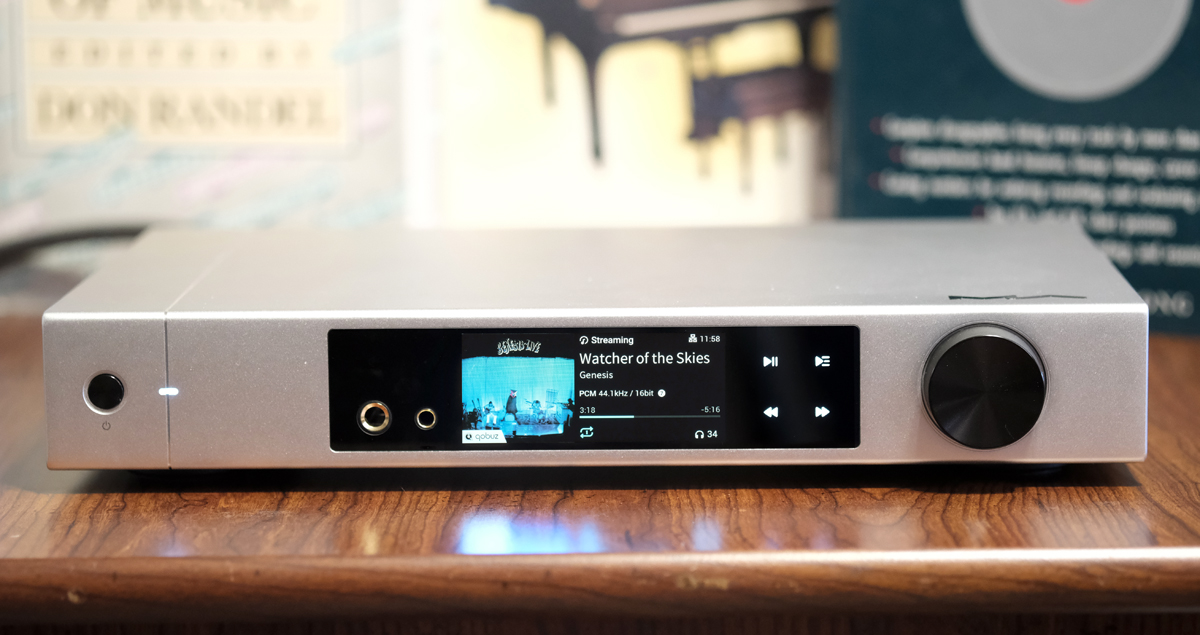
Sleek is the best description of the appearance of the Matrix Audio Element X2 Music Streamer, with its rolled aluminum chassis and inset side vents. The front is adorned with a control knob, the touchscreen display, a 4.4mm TRRRS balanced headphone output, a 1/4″ TRS single-ended headphone output, an LED, and the power button, that’s it. The back is a little more crowded with both single-ended (RCA) and balanced (3-pin XLR) Analog Outputs, a single-ended (RCA) Analog Input, two coaxial and two TOSLINK S/PIDF Digital Inputs, an IIS*LVDS Input (HDMI), an HDMI ARC Input, a Reset button, a USB Audio Input (USB Type B), a USB Type C connection, an Ethernet port, a Trigger Output, a Trigger Input, and the AC receptacle.
The list of features and functions of the Matrix Audio Element X2 Music Streamer is long indeed.
- Built-in full-balanced headphone amplifier, which is composed of 8 independent amplification units, every 2 units are connected in parallel, to provide higher drive current and output power with very low distortion and noise, and better control of micro-details to the headphone speaker units. Hence there are no hard-to-drive headphones for element X2.
- Built-in pre-amplifier with +10dB analog gain that can output high-quality audio signals up to 15.8VRMS which combined with Hyper-Control relay array volume control technology lets the entire output range stay ultra-low in noise and distortion.
- Matrix Audio’s MA player allows you to easily browse and play music from USB drives or NAS.
- High-res online streaming via TIDAL, Qobuz, Spotify, and Internet radio.
- Roon Ready, plus DLNA/UPnP and AirPlay 2 support.
- Equipped with a 3.46-inch LCD touchscreen that allows you to perform various operations more conveniently via newly added playback touch keys.
- When playing over the network, or playing local music via MA player, rich information on the track is displayed on the screen.
- MA Remote App available for iPhone, iPad, or Android phones allows you to browse and play back your local music files, online music stream from TIDAL and Qobuz, and even Internet radio stations. Device configurations and firmware updates also can be managed through the app.
- Multiple digital input ports along with added analog input ports with high, medium, and low input gain options available to adapt to the different output levels of the front-end device.
- HDMI ARC (Audio Return Channel) input port for connection to display devices such as TVs and projectors with HDMI ARC functionality for higher quality playback.
- HDMI CEC (Consumer Electronics Control) protocol support, the element X2 can be controlled by HDMI CEC display device.
- built-in Crystek CCHD-950 ultra-low phase noise femtosecond clock, which can effectively reduce the jitter generated in the transmission and aid in the processing of digital audio signals.
- Switchable async mode and sync mode. In Async mode, the master clock of the D/A chip comes from the built-in Crystek CCHD-950 femtosecond clock, and the clock from the front-end device is abandoned. In the Sync mode, the built-in femtosecond clock will be turned off, and the D/A chip will depend on the clock of the front-end device completely.
- 2 independent power supplies are dedicated for the ARM processor and the digital audio processing separately. The 2 parts are in independent circuit units which are joined by several optocouplers to achieve complete electrical isolation. The analog audio circuit uses an independent linear power supply.
- Gigabit Ethernet port to ensure a more stable connection when streaming high sampling rate audio files.
- Integrated 2.4GHz and 5GHz dual-band Wi-Fi.
- Newly added trigger ports to turn the amplifier on or off with a single touch.
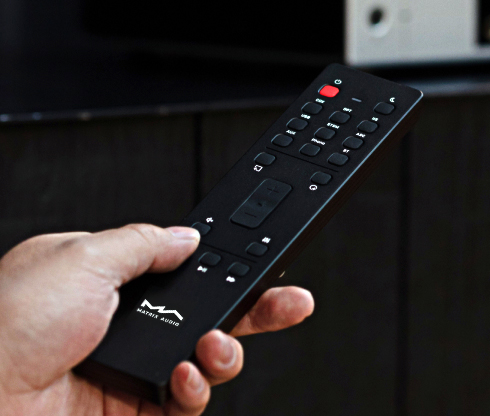
- New aluminum and plastic RM4 remote control with added playback control functions, making it more convenient to switch tracks, play, pause, and other operations, with 2 programmable buttons which can be set to your frequently used functions through the MA Remote App.

Living with the Matrix Audio element X2 Music Streamer:
Setting up the Matrix Audio element X2 Music Streamer was a matter of plugging it in, which was done with a Black Dragon Power Cord connected to my Core Power Technologies A/V Equi=Core 1000, connecting my hard drive via the USB-C port and letting it index the drive (which took about an hour for my 4TB drive), plugging in an ethernet cable (which is better for streaming than WiFi), and installing the MA app onto my Moto G Power smartphone.
Powering up the MA app, the element X2 showed up on the “My Devices” menu, there was an “Add Device” button indicating that you can run several Matrix Audio devices from a single app. Next to the element X2 was a “Configure” which gave access to a list of device settings. There was also a settings icon which gives access to the app settings as well as some Video Tutorials and the Matrix Audio Forum.
Entering the device menu (in the app), which is done by hitting a back arrow next to the device listing, you are greeted with a list of your albums which can be sorted by Artist, Genre, Composer, Performer, Age, or Label (these categories can be turned off if you don’t use them, other than “Artist”, “Track”, and “File”) if you have the proper metadata in your music files, since I have a combination of files with and without metadata, I found it easiest to search by file.
At the top of the screen there is a search bar, and a remote icon, if you click the remote icon you are presented with the remote functions (similar to those on the remote control). There is an icon that looks like an EQ icon but is in fact the filter menu (on the remote it will just toggle through the different filters). I did some listening tests and was surprised to hear how little difference there was between the different filters though this does appear to be a characteristic of the ESS DACs, so I defaulted to Apodizing as this tends to be the most musical in my experience (some listeners will prefer the added sense of space that the pre-ring and post-ring of a Brickwall filter induces, think of it as added delay or reverb, but I find them to be harsh).
Returning to the “Library” screen, you will find an alphabet along the right side of your screen that allows you to go to a specific letter point on the album list. At the bottom of the screen, you will see the current song, the play/pause button, and the next track button. Below that are four icon buttons “Library” (which should be highlighted as that is the screen you are on), “Streaming”, “Internet Radio”, and “My Favorites”.
If you click on an album it will display the album tracks, which can be selected, or you can hit “Play” or “Shuffle” to start the album playing. If you click on the current playing strip at the bottom of the screen it will take you to the track screen where you will find the repeat function.
Clicking the Streaming icon takes us to the streaming audio screen which offers both TIDAL and Qobuz which you can toggle between by touching the name at the top of the screen.
Internet Radio offered up radio stations from around the world plus an endless list of podcasts.

I began my serious listening with the Dan Clark Audio EXPANSE Reference Open Backed Planar Magnetic Headphones (actually, I performed my filter tests using the HIFIMAN HE6se Open Backed Planar Magnetic Headphones as they are much less forgiving on the high-end) via the balanced output, selecting Hilary Hahn’s “Eclipse” (Andrés Orozco-Estrada & the Frankfurt Radio Symphony – 24-bit/48kHz – Qobuz). Unlike most Dan Clark Audio headphones the EXPANSE is fairly difficult to drive, requiring an amplifier that not only has lots of current but extreme control of the bottom end, a feat which the element X2 accomplished with aplomb. Hilary’s performance of “Violin Concerto in A Minor, Op. 53, B. 108 (Antonín Dvořák)” was set in a massive soundstage, with excellent dynamics and fantastic timbre. Hilary was placed forward of the rest of the orchestra and center stage. Her violin was sweet and energetic set against a chorus of individual strings with the brass adding weight to the overall sound and the individual woodwinds providing counterpoint. You could clearly hear the hall in the plucked instruments and the timpani added impact, but musicality was the overriding watchword.

Ironically, seeking to step away from classical I opened up Sun Ra Arkestra’s album “Living Sky” (24-bit/96kHz – Qobuz) and was confronted with a track entitled “Chopin” which though slow paced was anything but mellow. At least four layers of improvisational and dynamic horn were placed atop a background of avant-garde piano and varied percussion with a steady upright bass beat. The timing of the band was unbelievable. During the second track “Somebody Else’s Idea”, there was a plucking of a guitar string reinforced by someone striking a vibe in perfect time so that it sounded like a single instrument, and I found it mesmerizing that the element X2 let me hear all these details hidden in a chaotic cacophony of sound that appears to be the signature sound of this band (well there appear to be enough instruments that it might be better called an orchestra). Again the soundstage was vast and musicality was supreme eliciting a truly live music experience.
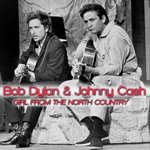
Moving to the Library for more familiar songs, I put on “Girl From The North Country” by Bob Dylan (DSD). The sound was intimate and personal with the guitar in the right channel and the harmonica in the left fading to the center at the end and Bob’s vocal in the middle. You can actually hear the silent click as they cut the harmonica track after the first pass showing this to be an early multi-track recording that began life as three mono recordings mixed together to give the impression of stereo.
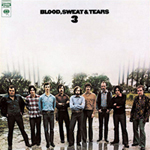
It was time to try some different headphones and my first choice was the recently reviewed Grado GS3000x due to its extreme efficiency it is an excellent judge of noise floor. In high gain at full volume, there was dead silence. This held true when listening to “The Battle” by Blood, Sweat & Tears (“Blood, Sweat & Tears 3” – DSD) which has several pregnant pauses allowing you to hear the pops and clicks of the recording under the suppressed tape noise. And once again the dynamics, impact, and musicality were epic in a large open studio a foot or two away.

As mentioned above I used the HE6se to check out the filter settings but still, I felt it warranted to offer my impressions as to the ability of the element X2 to deal with these notoriously hard-to-drive headphones. Even in low gain, the element X2 was well able to deliver on the demanding dynamics of Chick Corea & Gary Burton on piano and vibes respectively performing “Crystal Silence” from “Rendezvous In New York” (DSD). The quiet noises of the wait staff and patrons made it totally believable that you were at the performance in a spacious club if you but closed your eyes.

While not a likely combo, I felt it only right to see what the element X2 could do for an inexpensive ($200) pair of headphones and hooked up the HIFIMAN Deva Pro Open Backed Planar Magnetic Headphones. Queueing up “The Crystal Ship” (The Doors – “The Doors” – DSD) I found myself turning down the volume several times as the element X2 overwhelmed the Deva Pro’s limited resolution, that being said the sound was spectacular, front row balcony at the Shrine Auditorium.
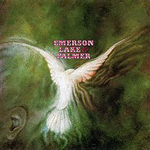
Knowing the element X2 is meant to be not just a Streaming DAC/Headphone Amp, but the front end of your whole system, it was time to see how it performs as a straight DAC, so I connected it to my LSA VT-70 Tube Integrated Stereo Amplifier/Headphone Amplifier and went back to the EXPANSE since I don’t have speakers set up at the moment. Bringing up Emerson, Lake & Palmer’s “Take A Pebble” from their eponymous first album (24-bit/96kHz – Qobuz) the sound was glorious placing the element X2 among the very best sounding DACs that I have listened to on my system.

One final test, which I actually performed after I started writing the conclusion to this review as I realized it was necessary to cement my full recommendation, was my Noble Audio Viking Ragnar IEMs. Selecting a song I have been wanting to listen to for days now since discovering the album was finally available on Qobuz, “The Musical Box” from Genesis’ “Genesis Live” album, I was immediately struck by how subtle the volume control was at the bottom of the dial making this a perfect DAC/Amp for use with IEMs. I was also blown away to learn I could place the individual drums in the soundstage. The Ragnar and the element X2 were a fantastic synergistic combination, fully realizing the energy and excitement of the live performance without any harshness or distortion.
Conclusions on the Matrix Audio element X2 Music Streamer:
The Matrix Audio element X2 Music Streamer is everything it promised to be, a reference quality Music Streamer, Music Server, DAC, and Headphone Amplifier, proving what I have said all along, that the most important part of a DAC is the analog section. Providing excellent timbre, tonal balance, bass control (damping), dynamic range, transient response, resolution, a huge soundstage, solid imaging, and above all musicality, with the power to drive any headphone (I performed all of my tests other than noise tests in low gain), as well as being a superior front end for a loudspeaker system, the fact that it also contains the necessary computer parts to complete the job and function as a full music server, eliminating the need for an external source while streamlining the data chain is just icing on the cake. It is one of a handful of headphone amplifiers that I would recommend for the Dan Clark Audio EXPANSE or the HIFIMAN HE6se for that matter, in fact, at this point, I would recommend it for use with the SUSVARA or ABYSS headphones unheard. And as mentioned above, the same applies to IEMs which makes the element X2 a rare puppy indeed.
Simply put, the Matrix Audio element X2 Music Streamer is a one-stop product that truly does it all, with performance well in excess of its price class, which is saying something for a $4,399 reference DAC/Headphone Amplifier.
Price: $4,399
Manufacturer’s Website: https://www.moon-audio.com/matrix-audio-element-x2-music-streamer.html
Specifications
Hardware Platform
| CPU | NXP i.MX 6Quad 4x Cortex-A9 @1.2 GHz |
| D/A Chip | ES9038PRO |
| Clock Source | Crystek CCHD-950 |
Digital Input
| Coaxial & Optical | PCM 16-24Bit /44.1kHz, 48kHz, 88.2kHz, 96kHz, 176.4kHz, 192kHz |
| DSD 2.8MHz (DoP) | |
| IIS LVDS | PCM 16-32Bit /44.1kHz, 48kHz, 88.2kHz, 96kHz, 176.4kHz, 192kHz, 352.8kHz, 384kHz, 705.6kHz, 768kHz |
| DSD 2.8MHz, 5.6MHz, 11.2MHz (DoP) | |
| DSD 2.8MHz, 5.6 MHz, 11.2 MHz, 22.4MHz (Native) | |
| USB Audio | PCM 16-24Bit /44.1kHz, 48kHz, 88.2kHz, 96kHz, 176.4kHz, 192kHz, 352.8kHz, 384kHz, 705.6kHz, 768kHz |
| MQA 16-24Bit /44.1kHz, 48kHz, 88.2kHz, 96kHz, 176.4kHz, 192kHz, 352.8kHz, 384kHz MQA or MQA Studio stream | |
| DSD 2.8MHz, 5.6MHz, 11.2MHz (DoP) | |
| DSD 2.8MHz, 5.6MHz, 11.2MHz, 22.4MHz (Native) | |
| HDMI ARC | PCM 16-24Bit /44.1kHz, 48kHz, 88.2kHz, 96kHz, 176.4kHz, 192kHz |
AUX Input
| RCA | SNR: >-106dB A-weighting |
| THD+N: <0.0025%@1k, <0.0030%@20Hz-20kHz | |
| Frequency Response: 20Hz-20kHz ±0.07 -3dB@43kHz | |
| Channel Crosstalk: >-102dB | |
| Input Level: 2.1VRMS Maximum |
Line Output
| XLR | SNR: >-131dB A-weighting |
| THD+N:<0.00012%@1k, <0.00020%@20Hz-20kHz | |
| Frequency Response: 20Hz-20kHz ±0.05 -3dB@85kHz | |
| Crosstalk: >-146dB | |
| Output Level: 4.5VRMS@0dB,15.8VRMS@+10dB | |
| RCA | SNR: >-125dB A-weighting |
| THD+N:<0.00012%@1k, <0.00020%@20Hz-20kHz | |
| Frequency Response: 20Hz-20kHz ±0.05 -3dB@85kHz | |
| Channel Crosstalk: >-137dB | |
| Output Level: 2.2VRMS@0dB, 7.5VRMS@+10dB |
Headphone Output
| 4.4 mm balanced | SNR: >-119dB A-weighting |
| THD+N:<0.00055%@20Hz-20kHz 4VRMS | |
| Frequency Response: 20Hz-20kHz ±0.1 -3dB@85kHz | |
| Output Impedance:<12Ω | |
| Output Power: 2600mW@33Ω, 1100mW@300Ω, 580mW@600Ω, 1%THD | |
| Gain: +18dB@Low Gain, +28dB@High Gain | |
| 6.35 mm unbalanced | SNR: >-116dB A-weighting |
| THD+N:<0.00055%@20Hz-20kHz 2VRMS | |
| Frequency Response: 20Hz-20kHz ±0.1 -3dB@85kHz | |
| Output Impedance:<6Ω | |
| Output Power: 1600mW@33Ω, 290mW@300Ω, 150mW@600Ω, 1%THD | |
| Gain: +18dB@Low Gain, +28dB@High Gain |
Network
| LAN | 10/100/1000 Mbps |
| WLAN | 2.4 GHz / 5 GHz |
USB
| The USB port provides a maximum power of 5V/1A. |
| The USB port works with devices which conform to the USB mass storage standard and supports FAT, FAT32, exFAT, and NTFS file formats, but is not guaranteed to be compatible with all storage devices. |
Trigger
| Trigger in | DC 6-12V<10mA |
| Trigger out | DC 12V/50mA MAX |
MA player
| Controller app | MA Remote App |
| Local Playback | |
| Format Supported: | MP3 , WMA , WAV , AIF, AIFC, AIFF, AAC, FLAC, OGG, APE, ALAC, M4A, DSF, DFF, CUE |
| PCM Sampling Rate: | PCM 16-24Bit 44.1kHz, 48kHz, 88.2kHz, 96kHz, 176.4kHz, 192kHz, 352.8kHz, 384kHz, 705.6kHz, 768kHz |
| MQA 16-24Bit /44.1kHz, 48kHz, 88.2kHz, 96kHz, 176.4kHz, 192kHz, 352.8kHz, 384kHz MQA or MQA Studio stream | |
| DSD Sampling Rate: | DSD 2.8MHz, 5.6MHz, 11.2MHz, 22.4MHz |
| Roon Ready | |
| PCM Sampling Rate: | PCM 16-24 Bit /44.1kHz, 48kHz, 88.2kHz, 96kHz, 176.4kHz, 192kHz, 352.8kHz, 384kHz, 705.6kHz, 768kHz |
| MQA 16-24 Bit /44.1kHz, 48kHz, 88.2kHz, 96kHz, 176.4kHz, 192kHz, 352.8kHz, 384kHz MQA or MQA Studio stream | |
| DSD Sampling Rate: | DSD 2.8MHz, 5.6MHz, 11.2MHz, 22.4MHz |
| AirPlay 2 | The audio specs depend on the service provider |
| DLNA/UPnP | The audio specs depend on the service provider |
| TIDAL Connect | The audio specs depend on the service provider |
| Spotify Connect | The audio specs depend on the service provider |
| vTuner | The audio specs depend on the service provider |
Power Specs
| Power Voltage | AC 100V-120V 50/60Hz / AC 220V-240V 50/60Hz |
| Standby Power Consumption | < 5W |
| Maximum Power Consumption | < 50W |
Weight & Size
| Weight | 4 kg (8.82 pounds) |
| Size | Width: 340 mm (13.39 inches) |
| Depth: 259 mm (10.20 inches) | |
| Height: 58 mm (2.28 inches) |
Accessory
| RM4 remote control | x1 |
| Power cable | x1 |
| Quick start guide | x1 |
| Warranty card | x1 |















Reply
Want to join discussion?
Feel free to contribute!